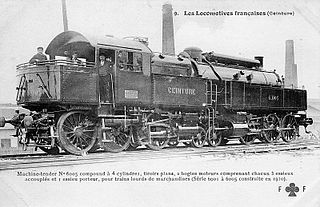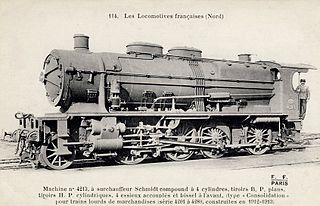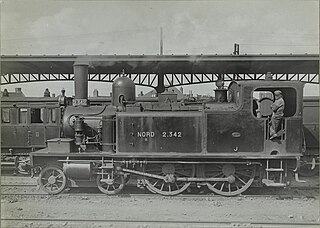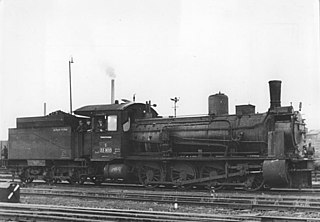
État 140-101 to 140-370 is a class of 2-8-0 steam locomotive of the Chemins de fer de l'État, and subsequently the Société Nationale des Chemins de fer Français (SNCF).

Nord 3.1201 to 3.1290 was a class of 90 Pacific (4-6-2) type steam locomotive of the Chemins de Fer du Nord. They served in the north of France and Belgium. The first batch were built in 1923, and last remaining were retired from service in the 1960s. These locomotives were widely known as "Superpacifics" due to their high performance, which made them famous even in Britain.
Jean-Jacques Meyer (1805–1877) was a French engineer, noted for his work with steam engines and steam locomotives.

The du Bousquet locomotive was an unusual design of articulated steam locomotive invented by French locomotive designer Gaston du Bousquet. The design was a tank locomotive, carrying all its fuel and water on board the locomotive proper, and a compound locomotive. The boiler and superstructure were supported upon two swivelling trucks, in a manner similar to a Meyer locomotive.
Gaston du Bousquet (1839–1910) was a French engineer who was Chief of Motive Power of the Chemin de Fer du Nord, designer of locomotives and professor at École centrale de Lille.
The Prussian G 12.1 was a German steam locomotive built for the Prussian state railways during the First World War and was the largest Prussian freight locomotive with a 2-10-0 wheel arrangement. It had three cylinders, the two outer ones driving the third axle and the inner one the second axle.

Nord 4.2016 to 4.2095 were a class of 0-8-0T locomotives of the Chemin de fer du Nord.

Nord 4.1201 to 4.1272 was a class of French Mikado tank locomotives built for suburban service on the Chemin de fer du Nord's lines that are north of Paris.

The Prussian T16 locomotives were ten-coupled superheated freight tank locomotives of the Prussian State Railways. They were later renumbered in the 94.2–4 by Deutsche Reichsbahn
Nord 5.1201 to 5.1230 were a class of 2-10-0 “Decapod” steam locomotives of the Chemins de Fer du Nord, designed to handle heavy coal trains. On 1 January 1938, they all passed to the SNCF, who numbered them 2-150.B.1 to 30.

Nord 4.061 to 4.340 were a class of 2-8-0 tender goods locomotives of the Chemins de fer du Nord. At nationalisation on 1 January 1938, they all passed to the SNCF who renumbered them 2-140.A.1 to 2-140.A.280.

Nord 2.231 à 2.305 were suburban 4-4-4T locomotives of the Chemins de Fer du Nord. They were nicknamed "Revolver" due to the appearance of the high-pitched small diameter boilers next to the low water tanks and cabs,

Nord 3.1101 and 3.1102 were a class of two express passenger 4-6-4 (Baltic) tender locomotives designed by Gaston du Bousquet for the Chemins de Fer du Nord, and built in the company's La Chapelle Workshops.
Ceinture 5001 to 5012 were a class of 2-10-2T tank locomotives of the Syndicat d'Exploitation des Chemins de fer de Ceinture de Paris. They were used for hauling freight trains on the Grande Ceinture line in Paris, and later the Région Nord.

Ceinture 4001 to 4005, was a class of five 4-8-0T tank locomotives designed by the Chemins de fer de l'Ouest for the Syndicat d'Exploitation des Chemins de fer de Ceinture de Paris.

Ceinture 51 to 65 were a class of fifteen 4-6-0T locomotives built in 1902 for the Syndicat d'Exploitation des Chemins de fer de Ceinture de Paris. They passed to the Chemins de fer du Nord in 1934 who renumbered them Nord 3.701 to 3.715. In 1938 they passed to the SNCF who renumbered them 230.TA.1 to 230.TA.6.

Ceinture 21 to 35 were a class of fifteen French 0-6-0T locomotives of the Syndicat d'Exploitation des Chemins de fer de Ceinture de Paris. built in 1899 for pulling suburban passenger trains.

SNCF 232.U.1 is a French steam locomotive of the Hudson type.

Nord 2.311 to 2.380, were 4-4-0T locomotives for suburban passenger traffic of the Chemins de Fer du Nord. The machines were built in 1892–1893. They were nicknamed "Ravachol" because of the entry into service of the series when the latter was arrested in April 1892.

The Prussian G 7.2 was a class of 0-8-0 tender compound locomotives of the Prussian state railways. In the 1925 renumbering plan of Deutsche Reichsbahn, the former Prussian locomotives produced from 1895 to 1911 were given the class designation 55.7–13; while the locomotives of former Mecklenburgische Friedrich-Franz-Eisenbahn (MFFE) locomotives were classified as 55.57.















